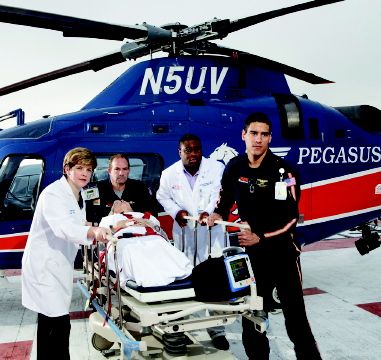
At a Glance
- UVA has adopted procedures to improve response to five of the most acute cardiovascular and cerebrovascular emergencies
- UVA accepts all emergent stroke, STEMI and aortic emergencies 24/7 and is never on divert for true emergencies
- Technology closes the gap between first responders and ER physicians
- The primary goals are to bring the decision point to the patient and reduce the time to treatment
As David Burt, MD, sees it, it is not just the experience and expertise of an emergency room staff that saves lives. It is also the systems they put in place to maximize the potential of that expertise.
“In some cases, you don’t have a second chance to get it right,” says Burt, an emergency medicine physician and director of UVA Chest Pain Center. “That’s why we have established a series of detailed, well-thought-out procedures for five of the most acute cardiovascular and cerebrovascular emergencies.” They are stroke, ST-elevation myocardial infarction (STEMI), sudden cardiac arrest, aortic dissection and aneurysm, and pulmonary embolism.
“We can provide more effective care for patients because we’ve created systems based on the best available data,” Burt says. “Equally important, when the process of delivering care is second nature, you can give your full attention to the patient.”
Bring the Decision Point to the Patient
The systems Burt and his colleagues have established for each of these low-incidence, high-impact events share a number of characteristics. The first, in Burt’s words, is that they bring the “decision point to the patient.”
This is a relatively straightforward task when a person walks into the UVA emergency room. It gets measurably more complicated when a person has been transferred from another hospital or when a rescue squad responds to a 911 call. In these instances, technology closes the gap by linking physicians at other locations and EMTs to a 24/7 emergency response officer at UVA.
For example, if emergency room physicians at another hospital suspect a patient of having a stroke, they can contact UVA’s Stroke Team Leader, a neurologist on call 24/7 who they can consult by phone or through the Virginia Acute Stroke Telemedicine network. Together, they can determine the kind of stroke the patient is having and whether physicians should administer the clot-busting drug tPA.
Similarly, if EMTs arrive at the home of a patient whose symptoms could indicate a STEMI, the procedure is for them to do an EKG within 10 minutes, transmit it to UVA’s 24/7 STEMI Alert Fellow or, if that is not possible, phone or radio in the results. UVA also has a Triage Officer Team for aortic emergencies and is instituting a Pulmonary Embolism Officer position.
“For each diagnosis, we have an experienced ‘triage office on call’ to help outside physicians give the best care,” says Burt. “The outside physician merely calls the UVA Transfer Center to get connected for a consult.”
Reduce the Time to Treatment
Once a diagnosis is made, the second stage in UVA’s systems for these cardiovascular emergencies kicks in: get the patient treatment as quickly as possible. In the case of a heart attack, the Triage Officer initiates a cascade of events, including mobilizing the on-call STEMI team. Within 30 minutes, they will have assembled in the Cardiac Catheterization Lab, reviewing images and other patient data while waiting for the ambulance to arrive. In the case of aortic aneurysm, the corresponding response is to have a vascular or thoracic surgeon team waiting in an operating room. “We practice what has been called checklist medicine,” Burt says. “Rather than diminish our autonomy as professionals, it sets the stage for us to be better physicians and provide better outcomes for our patients.”
Technology and Relationships
Continuous improvement is at the heart of the UVA approach. Once you have a system in place, Burt points out: “You have something to work with. You can look for ways to refine it to make it more efficient.” For instance, UVA is constantly exploring ways to utilize technology to accelerate the time to diagnosis and treatment. Earlier this year, UVA physicians conducted a trial evaluating a low-cost, tablet-based videoconferencing system that could be used to enable neurologists to assess probable stroke patients while they are in transit.
At the same time, Burt emphasizes that the emergency room team is always looking for ways to strengthen relationships — with physicians at other emergency departments, with local EMTs and with specialists across UVA. “Relationships are as important to the system as checklists,” Burt says. “When people know each other, the system is apt to work that much more smoothly, and people tend to be more open to assessing and fine-tuning their performance.”